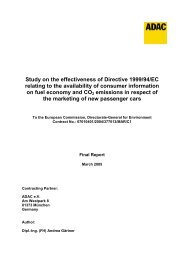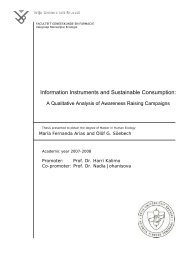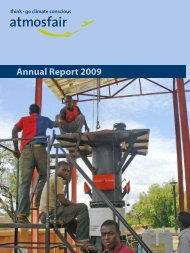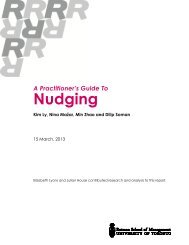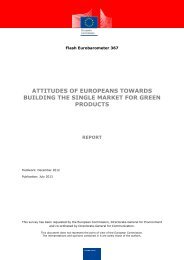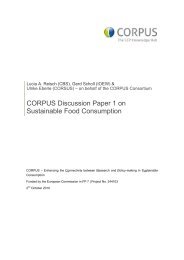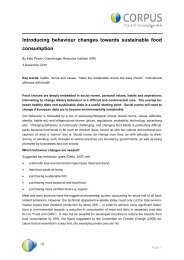Issues in Sustainable Housing - The SCP Knowledge Hub
Issues in Sustainable Housing - The SCP Knowledge Hub
Issues in Sustainable Housing - The SCP Knowledge Hub
Create successful ePaper yourself
Turn your PDF publications into a flip-book with our unique Google optimized e-Paper software.
<strong>Issues</strong> <strong>in</strong> Susta<strong>in</strong>able Hous<strong>in</strong>g<br />
1 st “Policy meets research“ Workshop<br />
Hels<strong>in</strong>ki, 24 th November 2011<br />
Pål Strandbakken<br />
funded <strong>in</strong><br />
National Institute for Consumer<br />
Research (SIFO)
Our focus<br />
– Susta<strong>in</strong>able hous<strong>in</strong>g is a very broad concept. We have to<br />
narrow it down <strong>in</strong> order to deal with it<br />
– We first want to concentrate on energy use and energy<br />
sav<strong>in</strong>gs <strong>in</strong> households. This is the major challenge.<br />
– Second, we adress environmental themes beyond energy<br />
use (pollution, landscape use etc.).<br />
– Third, we comment some aspects of socially susta<strong>in</strong>able<br />
hous<strong>in</strong>g.<br />
2<br />
<strong>Issues</strong> <strong>in</strong> Susta<strong>in</strong>able Hous<strong>in</strong>g
Focus contiued<br />
– This means that there are a number of important themes and<br />
issues that are left out or only briefly commented upon:<br />
– Infrastructure beyond energy; like waste management, water<br />
supply, sewage and broadband/telecommunications.<br />
– <strong>The</strong> very important <strong>in</strong>terface with mobility (urban density,<br />
urban sprawl, area plann<strong>in</strong>g, networks of road & rail)<br />
– Production, except for energy production<br />
3<br />
<strong>Issues</strong> <strong>in</strong> Susta<strong>in</strong>able Hous<strong>in</strong>g
Susta<strong>in</strong>ability and hous<strong>in</strong>g<br />
– <strong>The</strong>re seems to be no commonly accepted def<strong>in</strong>ition of<br />
susta<strong>in</strong>able hous<strong>in</strong>g<br />
– But we do have def<strong>in</strong>itions for special reports and studies.<br />
<strong>The</strong> Irish statement on hous<strong>in</strong>g policies; Deliver<strong>in</strong>g Homes;<br />
Susta<strong>in</strong>able Communities (2007) gives a def<strong>in</strong>ition of<br />
susta<strong>in</strong>able communities: “Susta<strong>in</strong>able communities have a<br />
high quality natural and built environment, with a dynamic<br />
and <strong>in</strong>novative economy, good transport, supportive<br />
community and voluntary services, and are environmentally<br />
sound” and ”they meet the diverse needs of exist<strong>in</strong>g and<br />
future residents, are sensitive to their environment and<br />
contribute to a high quality of life”.<br />
4<br />
<strong>Issues</strong> <strong>in</strong> Susta<strong>in</strong>able Hous<strong>in</strong>g
Energy use and emissions from the sector<br />
A rather common rule of thumb is that the environmental<br />
impact of consumption splits <strong>in</strong>to one third from food, one third<br />
from mobility and one third from hous<strong>in</strong>g.<br />
“Build<strong>in</strong>gs” account for some 40 % of direct energy consumption<br />
and 36 % of CO2 emissions <strong>in</strong> the European Union.<br />
<strong>The</strong> precise figures may be contested, and the relation between<br />
consumption of energy and GHG emissions will vary between<br />
countries due to their different energy mixes.<br />
Nevertheless, emissions from private consumption are<br />
considerable and national differences are only moderately<br />
<strong>in</strong>terest<strong>in</strong>g <strong>in</strong> a European market<br />
5<br />
<strong>Issues</strong> <strong>in</strong> Susta<strong>in</strong>able Hous<strong>in</strong>g
What can private consumers do about their<br />
energy use and GHG emissions from hous<strong>in</strong>g?<br />
– Put simple, they have two options:<br />
1. they can use less energy, by chang<strong>in</strong>g behavior and/or by<br />
us<strong>in</strong>g technology<br />
«Behavior» here would <strong>in</strong>clude area per person, <strong>in</strong>door<br />
temperature, use of light, turn<strong>in</strong>g off/turn<strong>in</strong>g down, while<br />
«technology» means <strong>in</strong>sulation, energy efficient appliances as<br />
well as energy sav<strong>in</strong>g technologies (like heat pumps)<br />
2. they can try to get their energy supply from renewable<br />
sources<br />
Some power companies offer electricity from renewable<br />
sources at a slightly higher price<br />
6<br />
<strong>Issues</strong> <strong>in</strong> Susta<strong>in</strong>able Hous<strong>in</strong>g
Reduced energy use from hous<strong>in</strong>g: <strong>The</strong><br />
Consumers’ options<br />
In the ideal detached house, the consumer<br />
should consider the follow<strong>in</strong>g:<br />
- Insulation (attic, roof, external and even<br />
<strong>in</strong>ternal walls, floor, pipes & boiler)<br />
- Energy efficient appliances (white good,<br />
light bulbs etc.)<br />
- Energy efficient heat<strong>in</strong>g technologies<br />
(heat pumps, automatic temperature<br />
control, smart meters)<br />
- Installation of solar panels for space<br />
heat<strong>in</strong>g, water heat<strong>in</strong>g or electricity<br />
production<br />
- Plus behavior change (lower<br />
temperature, less shower<strong>in</strong>g, turn<strong>in</strong>g off<br />
lights)<br />
Source: <strong>The</strong> Fresh Project<br />
7<br />
<strong>Issues</strong> <strong>in</strong> Susta<strong>in</strong>able Hous<strong>in</strong>g
Aggregate effects<br />
– We have a situation where the environmental issue ma<strong>in</strong>ly<br />
consists of <strong>in</strong>dividually <strong>in</strong>significant acts (my personal<br />
contribution is negligible) that add up to our present<br />
problems:<br />
– If we choose to narrow it down to electricity, we f<strong>in</strong>d that <strong>in</strong><br />
the European Union, white goods account for 40 % of<br />
households’ electricity consumption<br />
and<br />
– It has been estimated (CECED 2008) that Europe might reach<br />
6% of Kyoto targets only by replac<strong>in</strong>g old and <strong>in</strong>efficient<br />
white goods<br />
<strong>Issues</strong> <strong>in</strong> Susta<strong>in</strong>able Hous<strong>in</strong>g
Consumer change<br />
– This means that we are more <strong>in</strong>terested <strong>in</strong> small changes<br />
among large consumer groups than <strong>in</strong> large changes and<br />
sacrifice among a small group of activists<br />
– From a researcher’s po<strong>in</strong>t of view, this perspective should<br />
guide politics as well<br />
– <strong>The</strong> authorities’ ability to <strong>in</strong>fluence consumer behavior <strong>in</strong> the<br />
field of domestic energy use and sav<strong>in</strong>g og via regulation,<br />
economic measures/<strong>in</strong>centives and programs adress<strong>in</strong>g<br />
consumer conciousness<br />
9<strong>Issues</strong> <strong>Issues</strong> <strong>in</strong> susta<strong>in</strong>able Susta<strong>in</strong>able hous<strong>in</strong>g Hous<strong>in</strong>g
Renewable sources<br />
– In some European countries households are offered the<br />
opportunity to buy electricity from renewable sources. <strong>The</strong>re<br />
is, however, no possibility to identify its source.<br />
So the idea is that the power company is able to charge extra<br />
for the exact amount of electricity it produces from w<strong>in</strong>d, sun or<br />
other. <strong>The</strong> company gets an <strong>in</strong>centive for <strong>in</strong>creas<strong>in</strong>g the<br />
production of renewable energy<br />
<strong>The</strong> consumer supports a good cause economically, and <strong>in</strong><br />
addition sends a message to politicians and stakeholders<br />
10<br />
<strong>Issues</strong> <strong>in</strong> Susta<strong>in</strong>able Hous<strong>in</strong>g
Energy supply<br />
– Beyond this attempt at <strong>in</strong>fluenc<strong>in</strong>g the <strong>in</strong>centive system,<br />
energy supply obviously is and rema<strong>in</strong>s the responsibility of<br />
the political authorities, ma<strong>in</strong>ly on Member State level<br />
– In the UK, energy from renewable sources only accounted<br />
for 2% of the total (<strong>in</strong> 2007), while comparable data from<br />
France give approximately 14% renewable energy <strong>in</strong> 2010<br />
versus 17 % for Germany<br />
– Even for a pioneer country like Denmark, w<strong>in</strong>d power still<br />
only delivers approximately 5% of total production<br />
11<br />
<strong>Issues</strong> <strong>in</strong> Susta<strong>in</strong>able Hous<strong>in</strong>g
Susta<strong>in</strong>able energy<br />
– On the positive side, the potential for develop<strong>in</strong>g energy<br />
supply from renewable sources is big; with w<strong>in</strong>d, hydro,<br />
solar, geothermal and biofuelled. In addition, energy sav<strong>in</strong>g<br />
is a huge potential alternative power plant.<br />
– Negatively, we fear that the development goes too slow. In<br />
addition, the economic problems <strong>in</strong> the Eurozone is<br />
constra<strong>in</strong><strong>in</strong>g ambitious policies.<br />
– <strong>The</strong> most promis<strong>in</strong>g example at the moment is probably the<br />
German «Energiewende»/Energy turn.<br />
– Germany aims at phas<strong>in</strong>g out nuclear energy by 2022, and at<br />
the same time reduce CO2 emissions by 40% (ref. year 1990).<br />
12<br />
<strong>Issues</strong> <strong>in</strong> Susta<strong>in</strong>able Hous<strong>in</strong>g
Further environmental issues <strong>in</strong> hous<strong>in</strong>g<br />
Resource use: Recycled or second hand (re-used) materials<br />
should be <strong>in</strong>corporated; reclaimed lumber, locally obta<strong>in</strong>ed<br />
stone.<br />
Landscape deprivation: Large areas are consumed for build<strong>in</strong>g<br />
residental areas with necessary traffic <strong>in</strong>frastructure<br />
Pollution: Production of build<strong>in</strong>g components (eg rockwool) is<br />
very pollut<strong>in</strong>g<br />
Indirect/embedded energy: Production of houses/build<strong>in</strong>g<br />
structures consumes huge amounts of energy<br />
13<br />
<strong>Issues</strong> <strong>in</strong> Susta<strong>in</strong>able Hous<strong>in</strong>g
Social susta<strong>in</strong>ability of hous<strong>in</strong>g<br />
– Some 30 million people or 6 % of the population <strong>in</strong> the EU 27<br />
area were reported to suffer from severe hous<strong>in</strong>g deprivation<br />
like noise, lack of space (overcrowd<strong>in</strong>g), crime, pollution or<br />
other hous<strong>in</strong>g related problematic conditions <strong>in</strong> 2009.<br />
– More than 12 % lived <strong>in</strong> households affected by high hous<strong>in</strong>g<br />
costs. Families with small children were more affected by<br />
poor hous<strong>in</strong>g conditions than households with only adults.<br />
– Less than 4 % lacked basic sanitary facilities, but problems<br />
with leak<strong>in</strong>g roofs (16 %), and darkness <strong>in</strong> the dwell<strong>in</strong>g (7 %)<br />
were more widespread.<br />
14<strong>Issues</strong> <strong>Issues</strong> <strong>in</strong> susta<strong>in</strong>able Susta<strong>in</strong>able hous<strong>in</strong>g Hous<strong>in</strong>g
Social policy and agreeable neighborhoods<br />
– <strong>The</strong> ma<strong>in</strong> focus has had to be on the dwell<strong>in</strong>gs’ technical<br />
standards; water, sewage, <strong>in</strong>sulation, size, and “quality”<br />
more <strong>in</strong> general. In addition, however, policy makers have to<br />
consider questions of urban development and of good<br />
quality neighbourhoods.<br />
– Susta<strong>in</strong>able hous<strong>in</strong>g policies are then supposed to<br />
contribute to creat<strong>in</strong>g more attractive and safer<br />
neighbourhoods; with less crime and unrest, better<br />
educational and cultural facilities and so on.<br />
15<strong>Issues</strong> <strong>Issues</strong> <strong>in</strong> susta<strong>in</strong>able Susta<strong>in</strong>able hous<strong>in</strong>g Hous<strong>in</strong>g
Thank you.<br />
Pål Strandbakken<br />
National Institute for Consumer Research (SIFO)<br />
pal.strandbakken@sifo.no<br />
24 th November 2011<br />
funded <strong>in</strong>



